
Features
Operations
Sound course of action
It was a week to celebrate royalty in Calgary in early July but newlyweds Kate and William weren’t the only ones under the microscope.
September 26, 2011 By Stacy Bradshaw
It was a week to celebrate royalty in Calgary in early July but newlyweds Kate and William weren’t the only ones under the microscope.
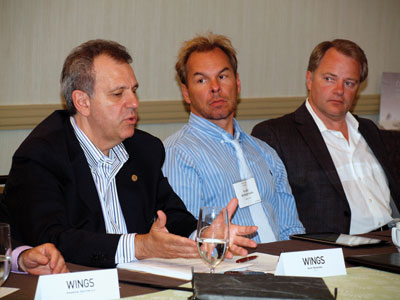 |
|
| CBAA president/CEO Sam Barone (left) explains ongoing changes with the POC process as MBE Jet’s CEO Marc Bombenon (middle) and Chartright Air Group president Adam Keller look on. photo: Alison De Groot
|
Ten high-profile leaders of Canada’s BizAv community – including CBAA president/CEO Sam Barone – took centre stage prior to the Canadian Business Aviation Association’s annual conference to participate in Wings first annual industry roundtable. (see, “The Group of 10,” pg. 32)
The invitation-only event July 5 featured lively discussion on a wide range of topics ranging from the effects of a stagnant economy to the challenges of dealing with Transport Canada following the federal government’s decision to take back the Private Operator’s Certificate process earlier this year. The ongoing importance of training, retaining top employees, safety and how to deal with the impending skill shortage in aviation were just a few of the other topics covered in the two-hour gathering.
When the proceedings wrapped up after two efficient hours of discussion the challenges remained but solutions and strategies to conquer tough issues had germinated. In this exclusive report, our esteemed panel discusses current economic realities, the effects of the POC changes on the market and the task of enhancing BizAv’s role across the country. For more coverage of the event via our special video series, go to www.wingsmagazine.com.
Economic realities: The BizAv perspective
A volatile economy has had a marked impact on all sectors of Canadian aviation and the BizAv community has had its own unique challenges. And while some organizations haven’t felt a huge impact, for others, it’s been a juggling act. So, how have those on our esteemed panel coped and is there a positive outlook on the horizon? Just how important is BizAv in driving the economy in Canada? Does the BizAv community have an inferiority complex?
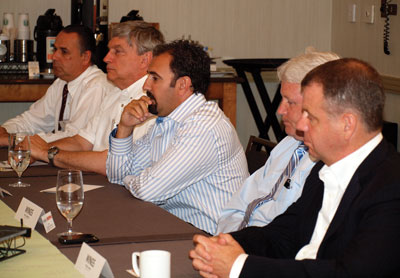 |
|
| Finding constructive solutions when working with Transport Canada was just one of the key topics for our 10 esteemed panel members. PHOTOs: Alison De Groot |
As a trained economist who closely follows current market conditions and their ramifications on his association’s members, CBAA president/CEO Sam Barone was anxious to get the ball rolling. “I think when we talk about volatility in the way our business models are shaping up, when we take a look at the traditional way our businesses have been undertaken, there once was a pattern – now we are in a down cycle or now it’s an up cycle,” Barone said. “That criteria of economic thinking doesn’t exist anymore. Now, there’s continuous volatility, continuous upheaval, variables are more difficult to manage. And while we have some strong fundamentals in Canada, in terms of good interest rates and good economic management coming from government, we’re not isolated in this world – we are co-dependent on other economies.
“The other thing is change happens more rapidly from a perspective of not only technology, but political events – they take on a bigger meaning in terms of how we do business. So, while things are relatively stable in Canada, we have situations in the Middle East, we have volatile fuel prices, we have volatile economic conditions in the European community which all impact our core businesses in terms of the way we see business aviation.”
The volatile economy has also created a changing dynamic in terms of opportunities for the Canadian BizAv community, Barone added. In the past, North American markets garnered the initial focus, but emerging opportunities in Latin America, the Middle East, China, India and Russia are altering the way companies do business. The question becomes how do you manage in such an environment?
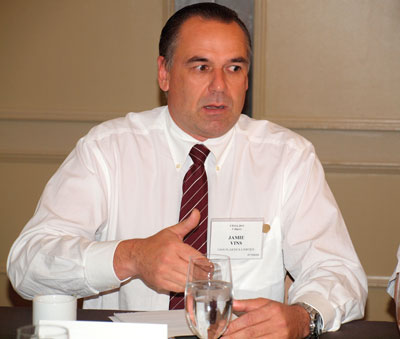 |
|
| “For us, the aircraft is an important tool . . . it allows us to get to customers quickly and efficiently.” – Jamie Vins, president/CEO, Vins Plastics Ltd. PHOTOs: Alison De Groot |
“It’s something far more complex than what we’ve seen in the past,” Barone said. “It requires different management skills, especially in aviation because aviation is the bellwether barometer of how the economy is going. So, the real opportunity for business aviation right now is definitely shifting from traditional markets.”
BC Campbell, VP of flight operations with Skyservice Business Aviation in Dorval, Que. concurred, noting that BizAv is an industry that doesn’t have huge business cycles in the first place. The biggest concerns are maintaining a high level of service and safety standards while watching costs. “And I think the regulatory framework is a big challenge for everyone,” he said. “But by and large, it is fairly consistent but always under pressure – you can’t take anything for granted.”
For government operations it’s pretty much business as usual notes Rob Madden, director of flight operations, Air Transport Service for the Alberta government. Madden, the chair of the CBAA’s board of directors, maintains that his flight department “is more of a communications tool.” Politicians need to get out to constituents throughout the year in good times or bad, so a volatile economy has little effect on the bottom line. In fact, tough times might mean an increase in activity.
“I would say when things are bad, it’s a little bit busier than normal because we have three million shareholders in the province of Alberta and they (politicians) use the aircraft to get around and dispel stories – or create new ones,” he said. “Politicians need to get out and everyone wants them at their chicken dinners.”
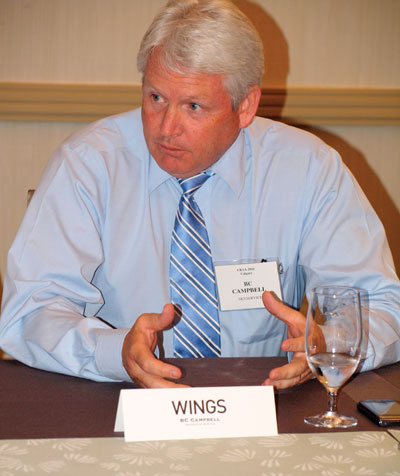 |
|
| “The regulatory framework is fairly consistent but always under pressure – you can’t take anything for graanted.” – BC Campbell, VP flight operations, Skyservice Business Aviation PHOTOs: Alison De Groot |
It’s a very different story for small business owners such as Jamie Vins who have definitely felt the pinch. The president/CEO of Bradford, Ont.-based Vins Plastic Ltd., is constantly seeking ways to cut costs without sacrificing service or safety. Vins heads up the family-owned producer of high-performance flexible packaging, celebrating it 35th anniversary this year. The company operates a single-engine Piper Meridian – an aircraft Vins maintains is critical to the success of the firm. As chief pilot, head of maintenance and pretty much in control of all flight ops, Vins has been taxed to the max keeping costs in check and service levels high. So, is owning an aircraft justified in a tight economy – is it a cost-effective tool?
“It’s a problem we face with clients because there’s a stigma attached to it,” Vins said. Business aircraft ownership even caught the eye of U.S. President Barack Obama, who, in June, vilified BizAv and its owners south of the border, questioning its value – even though it’s very much an economic enabler, driving business. “The question (for clients) becomes, are we paying too much for this product when he can show up in a private aircraft? Of course, they’re not realizing the aircraft is in fact a tool used to support the business. For us, the aircraft is an important tool . . . it allows us to get to our customers quickly and efficiently and still maintain that connection with our manufacturing facility.”
The stigma of affluence, lack of value and frivolity is very much a Canadian problem, noted Miguel Mendes, president of Mississauga, Ont.-based Image Air Charter. Mendes said it’s a problem Canadian business owners shouldn’t have to face, especially when the aircraft is an essential tool for an operation’s ultimate success.
“I think it’s very much the Canadian conservatism issue,” Mendes said, “because in the States, you hear them saying all the time that the company is doing great, they just bought a private jet (and it’s not a problem). But in Canada, the reaction is, ‘Whoa, that company is spending way too much money (especially in a downturn). They just bought their own private jet.’ Of course, they bought it for the same reasons that you are describing, Jamie, but there’s a stigma attached to the purchase.”
Marc Bombenon understands the stereotype associated with business jet owners – and in spite of a slowdown in the marketplace, he was adamant now is the best time to promote BizAv’s value. It’s a great opportunity for the CBAA to lead the charge. “I think this is clearly an area that this industry has to work hard to educate and identify,” said Bombenon, president/CEO of Calgary-based fractional ownership firm MBE Jets. “Jamie and Don (panelist Don Lockard, general manager of National Socket Screw Mfg. Ltd.) are avant-garde. They use corporate jets for their businesses and they understand the value of doing that – and we have to get the corporate world to understand the value as well.”
Barone concurred, adding that changing the perception of the BizAv community in the eyes of the federal government is a major challenge. He used the example of how the feds quickly legislated Air Canada service workers back to work in June after a few days on strike, noting that the airline was too valuable, as an economic enabler, to be out of commission.
“I was on the phone with the minister of transport and I told them, ‘We, too are an economic enabler’ because our members are the top 500 corporations in this country who operate aircraft. And not only that, we make it happen and create a lot of wealth and jobs . . . No, we’re not as flashy as Americans. But we are there conducting business, we’re just quieter about it. We have to educate people that we are doing business – and creating jobs in aerospace not only directly but indirectly at Pratt & Whitney, airports and so on.”
POC process: shifting perspectives
Dealing with economic realities and the prospects of highlighting BizAv’s relevance notwithstanding, the most significant issue influencing operators today is the fallout from the federal government’s decision to take back the Private Operator Certificate program from the CBAA. Since the change came into effect April 1, the CBAA’s role has understandably changed, moving instead from managing the issuing of operator certificates to concentrating on its role as an industry trade association.
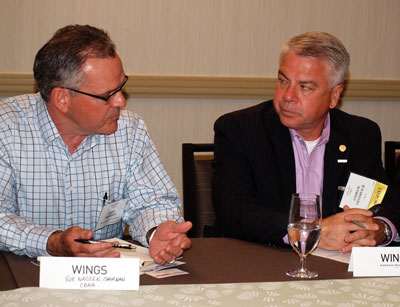 |
|
| Rob Madden, director of flight operations for the government of Alberta’s Air Transport Service (left), discusses his vision of the Canadian BizAv market with the CBAA’s Andrew Oestreich. PHOTOs: Alison De Groot |
It’s a significant change for the CBAA and operators, one that has led to plenty of animosity and questions about the government’s intentions, its ability to handle the transition, its inconsistent approach when dealing with audits and regulations, and the future ramifications for the Canadian BizAv community.
Barone, and other members of the CBAA team – many of whom were at the table – have spent hours working on behalf of members and individual business operators to smooth out the kinks – and help the government deal with the onerous task ahead. A frustrated but diplomatic Barone presented his best glass-half-full synopsis of the situation.
“From the CBAA’s point of view, things were fixed. But as of March 2010 when TC decided to take the POC back, there were opportunities and challenges,” he said. “We at once were a trade association, we also had to do a lot of regulatory activity. So, in a lot of ways, it has made our role of an association more clear. We can get back to our core business of being a trade association and voice more clearly without conflicts of interests in our messaging.
“However, at the same time, the challenge is we have to manage this change back to TC on behalf of our members. To say that TC was prepared when they made this decision is a complete falsehood. This was a political decision and I want to be fair to the officials that we work with on a daily basis because officials implement political decisions in Ottawa.”
Barone explained that TC faces huge organizational challenges in bringing back the POC because, once they divested of the program eight years ago (and entrusted it with the CBAA), they lost the organizational capacity to manage the program.
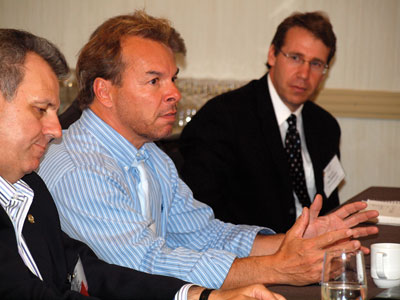 |
|
| MBE Jets’ CEO Marc Bombenon (middle) says the players in the Canadian BizAv market are often far too passive in promoting the valuable contributions the industry makes to the Canadian economy. PHOTOs: Alison De Groot |
The CBAA is trying to extract clarity from the understaffed POC team at TC to give BizAv owners the fixed variables they need to manage their operations properly. “That is a key success factor in ensuring safety,” Barone added. “We’re in a fiscal constraint era now so TC is not going to get more resources; they’re going to get fewer. Our members have to adapt to that. It’s translating to aircraft being on the ground, and delays on getting things done.”
Lockard said much of the challenge in working with TC centres around a communications breakdown – an inability to speak the same language. Lockard recently went through an “unofficial” two-hour audit with a TC inspector only to spend much of the time communicating what he actually uses his aircraft for. “Nice fellow, but ‘who are you?’ was his question to me. Two hours later, I was still explaining to him what I do, where I fly . . . it wasn’t a technical audit but it was trying to give them a sense of where we allocate our resources, and who do we need to look at. Are you an oil rig flier or are you a flat bed flier? That’s not right.”
Mendes concurred adding that the regulatory framework does not reflect the needs of business aviation operators – and there’s an inconsistency in enforcing it. Said Mendes: “I’ve found they’re making rules and regulations they don’t really understand . . . they don’t understand what business aviation is even about. We had a pretty high-up person at TC tell us ‘why don’t you fly commercial?’ Then he starts asking us, what the differences are. He’s the one running the ops inspections in Toronto.”
Starlink Aviation president/CEO Glen Lynch argued that current economic realities are intrinsically linked to the situation with the POC. The Canadian economy came through the recent downturn fairly well compared to other parts of the world, he said, but following the Big Three debacle in the U.S. in 2009, the public relations disaster for BizAv has been difficult to shake. Add in the unorganized transition of the POC, and it’s created a perfect storm that’s been difficult to overcome.
“The answer to the question, ‘where is the POC program at right now?’ is that there is no program,” said Lynch. “The question that is important to BizAv is, ‘what is this going to mean for the economy of our industry?’ At the moment, it’s too early to put any empirical data behind it, but what we’re seeing is more interest on the aircraft management side – not because individual business owners want to have their aircraft managed, or not because they want to operate them commercially, but at the moment, it’s the only way to get an airplane in the air.”
Parked aircraft are not helping companies stay economically viable – and it’s a fundamental issue the CBAA is taking steps to correct,” said Barone. “One of the things we’ve done as an association is bump up our staff to deal with these growing issues,” he said. “We now have the second former head of civil aviation Canada on as an advisor to us; the first was Art Laflamme and now Merlin Preuss so it’s not for a lack of expertise in telling them what we need to do. We go in there and we give them solutions; we draft things for them to look at.
“I don’t purport to be a civil aviation expert, but we now have the second former head of civil aviation of TC on staff, we have the former superintendent of business aviation who has now joined CBAA. TC is actually coming to us at times to guide them through the process.”
Finding solutions to the POC situation will not be easy, but Barone is confident they can be found. More funding, consultation, increased pressure on politicians to identify the problem and highlighting the important role BizAv plays in fueling the country’s economic engine – it will all help. Can it happen? Of course – or as Bombenon joked, the POC process and National Long Gun Registry may one day be forever linked in the same sentence due to gross mismanagement.
“What we want is more consultation and more input in the process – and that hasn’t been clear either,” Barone said. “So, it’s quite the frustrating challenge we are facing. But even against all of this, we are making progress I think we do have a collaborative relationship with them, I just think they don’t have the capacity to do it all at once and that’s creating a challenge.”
| The Group of 10
Jamie Vins Don Lockard Miguel Mendes BC Campbell Glen Lynch Rob Madden Andrew Oestreich Sam Barone Marc Bombenon Adam Keller |